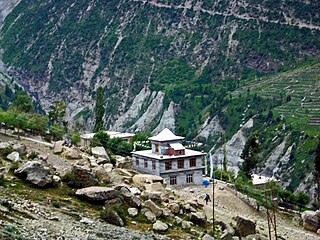 W
WGandhola Monastery is about 18 kilometres (11 mi) before Keylong in Lahaul and Spiti district, Himachal Pradesh, India on the road from Manali, Himachal Pradesh. It is located on a hill above Tupchiling Village at the sacred junction of the Chandra and Bhaga rivers, which together form the Chandrabhaga or Chenab River. The village is at 3,160 m (10,370 ft) and is famous for its 7-storey tower fort.
 W
WKhorzhak Monastery is a Buddhist monastery in Khorzhak town, Burang county, Ngari Prefecture in western Tibet. It is located not far to the southeast of Burang and just northeast of the Indian border. The town and temple are known as Kojanath in Hindi. The village is situated on a beautiful spot at a bend of the Karnali River from where one can see the large red wall of the temple facing the river with a huge inscription on it of the six-syllable mantra, OM MANI PADME HUM.
 W
WMoûtiers, historically also called Tarentaise, is a commune in the Savoie department in the Auvergne-Rhône-Alpes region in Southeastern France. In 2018, it had a population of 3,511.
 W
WThe Niujie Mosque is the oldest mosque in Beijing, China. It was first built in 996 during the Liao Dynasty and was reconstructed as well as enlarged under the Kangxi Emperor of the Qing Dynasty.
 W
WThe Benedictine Pannonhalma Archabbey or Territorial Abbey of Pannonhalma is a medieval building in Pannonhalma, one of the oldest historical monuments in Hungary. Founded in 996, it is located near the town, on top of a hill. Saint Martin of Tours is believed to have been born at the foot of this hill, hence its former name, Mount of Saint Martin, from which the monastery occasionally took the alternative name of Márton-hegyi Apátság. This is the second largest territorial abbey in the world, after the one in Monte Cassino.
 W
WThe basilica di San Pietro is a Catholic basilica and abbey in the Italian city of Perugia.
 W
WTabo Monastery is located in the Tabo village of Spiti Valley, Himachal Pradesh, northern India. It was founded in 996 CE in the Tibetan year of the Fire Ape by the Tibetan Buddhist lotsawa (translator) Rinchen Zangpo, on behalf of the king of western Himalayan Kingdom of Guge, Yeshe-Ö. Tabo is noted for being the oldest continuously operating Buddhist enclave in both India and the Himalayas. A large number of frescoes displayed on its walls depict tales from the Buddhist pantheon. There are many priceless collections of thankas, manuscripts, well-preserved statues, frescos and extensive murals which cover almost every wall. The monastery is in need of refurbishing as the wooden structures are aging and the thanka scroll paintings are fading. After the earthquake of 1975, the monastery was rebuilt, and in 1983 a new Du-kang or Assembly Hall was constructed. It is here that the 14th Dalai Lama held the Kalachakra ceremonies in 1983 and 1996. The monastery is protected by the Archaeological Survey of India (ASI) as a national historic treasure of India.